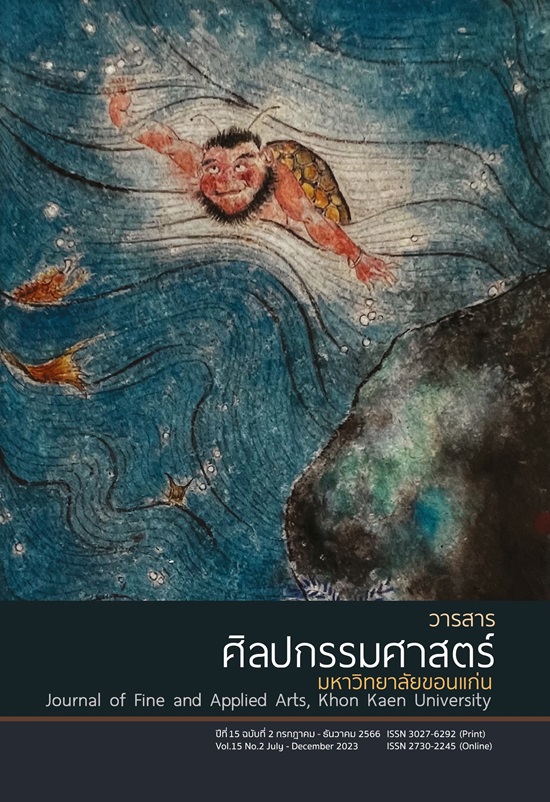Contemporizing Classical Thai Dance: Inspiration from Handcrafts to Mixed Multimedia Performance
Main Article Content
Abstract
Digital technology has gradually become ubiquitous in performing arts but is rarely used in traditional dance. This research studied how digital technology may be used in traditional Thai dance and the ways which contemporary dance may be created, maintaining cultural and traditional Thai dance roots by blending multimedia to communicate with audiences. New choreographic approaches were explored by combining elements of Thai and daily life to develop new Thai dance gesture forms. Choreographic concepts were inspired by Thai handcrafts, created with alluring varied weave patterns and methods reflecting different lifestyles and beliefs of regional populations. Dance composition theory and visual arts were used as design principles. Results were that experimental dance using multimedia technology materially conveys wisdom messages and meanings in communicating with audiences. The public is encouraged to appreciate weaving pattern esthetics and better understanding weaving techniques as well as the value and spirit of handcrafts. This creative work may be used as guideline for creating further new contemporary choreographic approaches based on blending traditional dance with multimedia in groundbreaking performances.
Article Details

This work is licensed under a Creative Commons Attribution-NonCommercial-NoDerivatives 4.0 International License.
Content and information in articles published in the Journal of Fine and Applied Arts of Khon Kaen University is regarded as the opinion and sole responsibility of the author(s) directly; therefore, editors are not obliged to agree to or share any responsibility with regard to the content and information that appears within these articles.
All articles, information, content, image, etc. that have been published in the Journal of Fine and Applied Arts of Khon Kaen University is the copyright of the Journal of Fine and Appllied Arts of Khon Kaen University. Any person or organization who wishes to distribute all or parts of the articles for further dissemination or other usage must first receive permission from the Journal of Fine and Applied Arts of Khon Kaen University before proceeding to do so.
References
วิบูลย์ ลี้สุวรรณ. (2540). เครื่องจักสานไทย. กรุงเทพฯ : องค์การค้าคุรุสภา.
สมปอง เพ็งจันทร์. (2546). เครื่องจักสานภาคเหนือ. เชียงใหม่ : ซิลค์เวอร์มบุคส์.
สำนักงานพัฒนาบริหารองค์ความรู้ (องค์การมหาชน). (2564). เครื่องจักล้านนาเสริมมงคล. ค้นเมื่อ 25 เมษายน 2564, จาก http://www.okmd.or.th/knowledge-box-set/articles/local-thai-culture/361/auspicious-lanna-basketry
อนุกูล ศิริพันธ์ และคณะ. (2562). “ศรัทธา สักการะ” ความเชื่อ สู่วิถีชีวิตชาวล้านนา: ถอดบทเรียนจากการจัดงานมหกรรมพิพิธภัณฑ์ท้องถิ่นล้านนา ครั้งที่ 1. กรุงเทพฯ : ศูนย์มานุษยวิทยาสิรินธร (องค์การมหาชน).
Laban, R. (2011). The mastery of movement. 4th ed. Hampshire, UK : Dance Books.
Konie, R. (2011). A brief overview of Laban movement analysis. Retrieved March 20, 2021, from http://psychomotorischetherapie.info/website/wp-content/uploads/2015/10/LMA-Workshop-Sheet-Laban.pdf
Satish, S. (2019). Technology and Dance Blending the Digital and Physical Worlds. Retrieved March 20, 2021, from https://medium.com/digital-literacy-for-decision-makers-columbia-b/technology-and-dance-blending-the-digital-and-physical-worlds- 33589ff2bdd6
Yuko, N., & Takeshi, O. (2012). Process of improvisational contemporary dance. Retrieved March 20, 2021, from https://escholarship.org/content/qt40739507/qt40739507_noSplash_138a8128c1c9f4237c64dbeb05b99b69.pdf?t=op2kak


